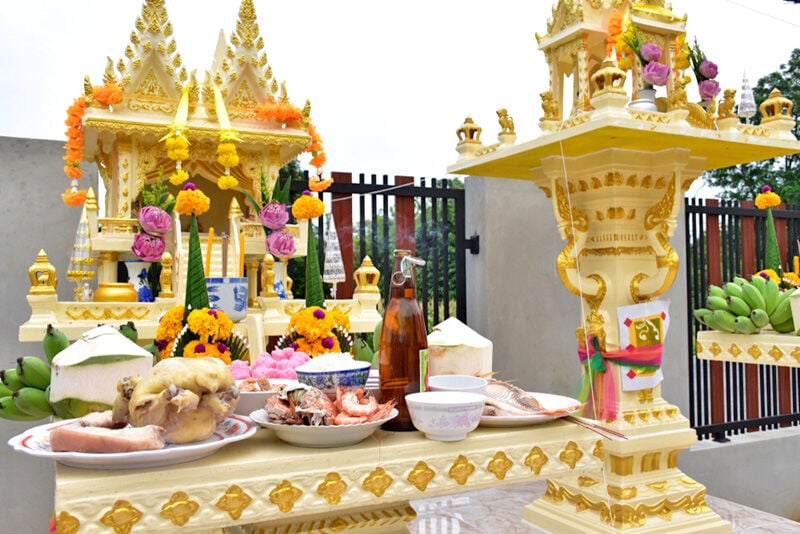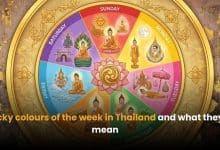Spirit houses in Thai culture

In the bustling streets and serene countryside of Thailand, one might notice small, ornate structures standing proudly on pedestals, often adorned with flowers and offerings. These are spirit houses, integral to Thai culture and spirituality. They serve as abodes for protective spirits, believed to safeguard homes, businesses, and public spaces from harm.
Spirit houses, known as “san phra phum” in Thai, come in various styles and sizes, reflecting the rich artistic heritage of the region. Typically, they feature a raised pedestal base, a roof, an altar, and sacred objects such as Buddha statues. These elements combine to create a sacred space that honours the spirits and invites their blessings.
The tradition of erecting spirit houses is deeply rooted in animist beliefs, which predate Buddhism in Thailand. Today, they are a ubiquitous sight, symbolising a harmonious blend of ancient traditions and modern life. Whether in bustling Bangkok or a quiet village in Phetchaburi, these structures stand as a testament to the enduring spiritual practices of the Thai people.
What is a spirit house?
Spirit houses, known as “san phra phum,” are integral to Thai culture. People believe these small, ornate structures house protective spirits. They are erected at homes, businesses, and public spaces to safeguard the area and its inhabitants.
What is inside a San phra phum?
A typical spirit house contains several elements. A raised pedestal base supports the structure. The roof is often elaborate, showcasing traditional Thai architectural styles. Inside, an altar holds sacred objects such as Buddha statues. Offerings frequently include food, drinks, and floral garlands to keep the spirits content.
Where should a San phra phum be positioned?
Positioning a Thai spirit house requires careful consideration. It should never fall within the building’s shadow it protects. Avoid placing it on the left side of a door, facing a toilet, or a road. Ideally, it should face north or northeast. The height should demand respect but allow easy access for daily offerings. Brahman priests often help identify auspicious spots for these structures.
Why make offerings at the spirit house?
Making offerings at San phra phum keeps the protective spirits happy. Offerings might include food, drinks, red and orange Fanta, candles, fresh flowers, and burning incense. Happy spirits ensure prosperity and protection for the property and its occupants. In some places, daily offerings are common while others do so only on special occasions.
How are the spirit houses made?
Crafting them is an art form. They reflect Thailand’s rich artistic heritage. Skilled artisans use materials like wood and ceramics. The design includes intricate patterns and motifs, often painting them in vibrant colours. Each piece is meticulously crafted to honour the spirits.
How to prepare for setting up a spirit house?
Preparation involves several steps. First, choose an auspicious location. Consult a Brahman priest if unsure. Next, ensure the spirit house is built according to traditional designs. Once positioned, decorate it with figures and sacred objects. A religious ceremony, usually led by a Brahman priest, invites the spirits to inhabit the house.
Keeping the spirits happy
Regular maintenance and offerings are essential. Clean the house and its surroundings. Provide items the spirits once enjoyed in life. Replace offerings like flowers and food regularly. Respect the space as a place of worship. These actions ensure harmonious coexistence between the living and the spirits.
How spirit house is important to Thai people?
 Spirit houses play a pivotal role in Thai culture. These structures, found at homes, businesses, and public spaces, serve as dwellings for guardian spirits. Their importance stems from both spiritual beliefs and traditional practices.
Spirit houses play a pivotal role in Thai culture. These structures, found at homes, businesses, and public spaces, serve as dwellings for guardian spirits. Their importance stems from both spiritual beliefs and traditional practices.
Thai people believe that a well-maintained spirit house ensures protection and prosperity. Offerings such as food, drinks, and flowers are placed as tokens of respect and gratitude. This ongoing interaction highlights the deep connection between the living and the spiritual world.
Respect for San phra phum is ingrained in daily life. Disrespect is thought to anger the spirits, leading to misfortune. Stories of people experiencing bad luck after offending spirits reinforce this belief. Thus, whether one believes or not, maintaining decorum around a spirit house is advised.
In essence, San phra phum is more than just decorative elements. They embody Thai values of respect, spirituality, and harmony. Their continued presence signifies the enduring nature of these cultural beliefs in modern Thai society.
Latest Thailand News
Follow The Thaiger on Google News:


























